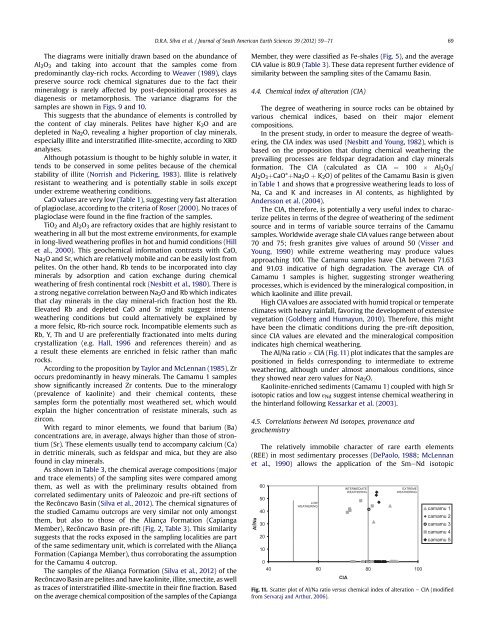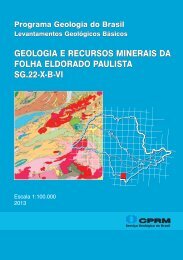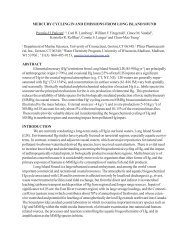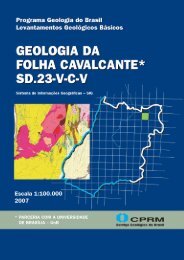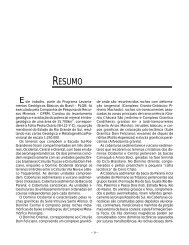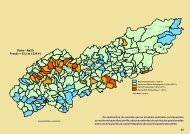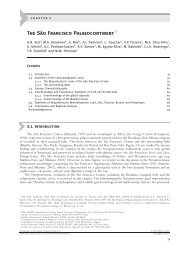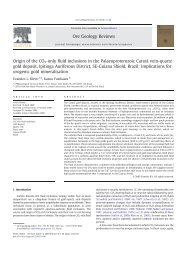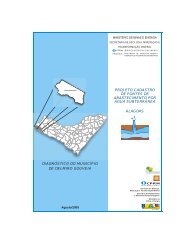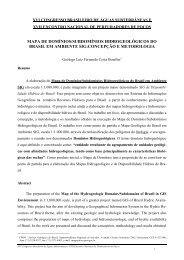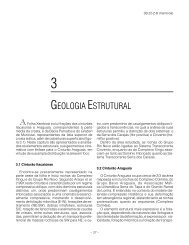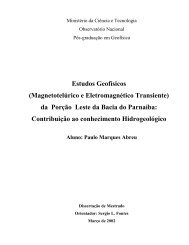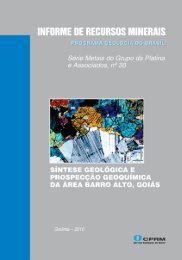Whole-rock geochemistry and Sr-Nd isotopic composition of ... - CPRM
Whole-rock geochemistry and Sr-Nd isotopic composition of ... - CPRM
Whole-rock geochemistry and Sr-Nd isotopic composition of ... - CPRM
Create successful ePaper yourself
Turn your PDF publications into a flip-book with our unique Google optimized e-Paper software.
The diagrams were initially drawn based on the abundance <strong>of</strong><br />
Al2O3 <strong>and</strong> taking into account that the samples come from<br />
predominantly clay-rich <strong>rock</strong>s. According to Weaver (1989), clays<br />
preserve source <strong>rock</strong> chemical signatures due to the fact their<br />
mineralogy is rarely affected by post-depositional processes as<br />
diagenesis or metamorphosis. The variance diagrams for the<br />
samples are shown in Figs. 9 <strong>and</strong> 10.<br />
This suggests that the abundance <strong>of</strong> elements is controlled by<br />
the content <strong>of</strong> clay minerals. Pelites have higher K2O <strong>and</strong> are<br />
depleted in Na2O, revealing a higher proportion <strong>of</strong> clay minerals,<br />
especially illite <strong>and</strong> interstratified illite-smectite, according to XRD<br />
analyses.<br />
Although potassium is thought to be highly soluble in water, it<br />
tends to be conserved in some pelites because <strong>of</strong> the chemical<br />
stability <strong>of</strong> illite (Norrish <strong>and</strong> Pickering, 1983). Illite is relatively<br />
resistant to weathering <strong>and</strong> is potentially stable in soils except<br />
under extreme weathering conditions.<br />
CaO values are very low (Table 1), suggesting very fast alteration<br />
<strong>of</strong> plagioclase, according to the criteria <strong>of</strong> Roser (2000). No traces <strong>of</strong><br />
plagioclase were found in the fine fraction <strong>of</strong> the samples.<br />
TiO2 <strong>and</strong> Al2O3 are refractory oxides that are highly resistant to<br />
weathering in all but the most extreme environments, for example<br />
in long-lived weathering pr<strong>of</strong>iles in hot <strong>and</strong> humid conditions (Hill<br />
et al., 2000). This geochemical information contrasts with CaO,<br />
Na2O <strong>and</strong> <strong>Sr</strong>, which are relatively mobile <strong>and</strong> can be easily lost from<br />
pelites. On the other h<strong>and</strong>, Rb tends to be incorporated into clay<br />
minerals by adsorption <strong>and</strong> cation exchange during chemical<br />
weathering <strong>of</strong> fresh continental <strong>rock</strong> (Nesbitt et al., 1980). There is<br />
a strong negative correlation between Na2O <strong>and</strong> Rb which indicates<br />
that clay minerals in the clay mineral-rich fraction host the Rb.<br />
Elevated Rb <strong>and</strong> depleted CaO <strong>and</strong> <strong>Sr</strong> might suggest intense<br />
weathering conditions but could alternatively be explained by<br />
a more felsic, Rb-rich source <strong>rock</strong>. Incompatible elements such as<br />
Rb, Y, Th <strong>and</strong> U are preferentially fractionated into melts during<br />
crystallization (e.g. Hall, 1996 <strong>and</strong> references therein) <strong>and</strong> as<br />
a result these elements are enriched in felsic rather than mafic<br />
<strong>rock</strong>s.<br />
According to the proposition by Taylor <strong>and</strong> McLennan (1985),Zr<br />
occurs predominantly in heavy minerals. The Camamu 1 samples<br />
show significantly increased Zr contents. Due to the mineralogy<br />
(prevalence <strong>of</strong> kaolinite) <strong>and</strong> their chemical contents, these<br />
samples form the potentially most weathered set, which would<br />
explain the higher concentration <strong>of</strong> resistate minerals, such as<br />
zircon.<br />
With regard to minor elements, we found that barium (Ba)<br />
concentrations are, in average, always higher than those <strong>of</strong> strontium<br />
(<strong>Sr</strong>). These elements usually tend to accompany calcium (Ca)<br />
in detritic minerals, such as feldspar <strong>and</strong> mica, but they are also<br />
found in clay minerals.<br />
As shown in Table 3, the chemical average <strong>composition</strong>s (major<br />
<strong>and</strong> trace elements) <strong>of</strong> the sampling sites were compared among<br />
them, as well as with the preliminary results obtained from<br />
correlated sedimentary units <strong>of</strong> Paleozoic <strong>and</strong> pre-rift sections <strong>of</strong><br />
the Recôncavo Basin (Silva et al., 2012). The chemical signatures <strong>of</strong><br />
the studied Camamu outcrops are very similar not only amongst<br />
them, but also to those <strong>of</strong> the Aliança Formation (Capianga<br />
Member), Recôncavo Basin pre-rift (Fig. 2, Table 3). This similarity<br />
suggests that the <strong>rock</strong>s exposed in the sampling localities are part<br />
<strong>of</strong> the same sedimentary unit, which is correlated with the Aliança<br />
Formation (Capianga Member), thus corroborating the assumption<br />
for the Camamu 4 outcrop.<br />
The samples <strong>of</strong> the Aliança Formation (Silva et al., 2012) <strong>of</strong>the<br />
Recôncavo Basin are pelites <strong>and</strong> have kaolinite, illite, smectite, as well<br />
as traces <strong>of</strong> interstratified illite-smectite in their fine fraction. Based<br />
on the average chemical <strong>composition</strong> <strong>of</strong> the samples <strong>of</strong> the Capianga<br />
D.R.A. Silva et al. / Journal <strong>of</strong> South American Earth Sciences 39 (2012) 59e71 69<br />
Member, they were classified as Fe-shales (Fig. 5), <strong>and</strong> the average<br />
CIA value is 80.9 (Table 3). These data represent further evidence <strong>of</strong><br />
similarity between the sampling sites <strong>of</strong> the Camamu Basin.<br />
4.4. Chemical index <strong>of</strong> alteration (CIA)<br />
The degree <strong>of</strong> weathering in source <strong>rock</strong>s can be obtained by<br />
various chemical indices, based on their major element<br />
<strong>composition</strong>s.<br />
In the present study, in order to measure the degree <strong>of</strong> weathering,<br />
the CIA index was used (Nesbitt <strong>and</strong> Young, 1982), which is<br />
based on the proposition that during chemical weathering the<br />
prevailing processes are feldspar degradation <strong>and</strong> clay minerals<br />
formation. The CIA (calculated as CIA ¼ 100 Al2O3/<br />
Al2O3þCaO*þNa2O þ K2O) <strong>of</strong> pelites <strong>of</strong> the Camamu Basin is given<br />
in Table 1 <strong>and</strong> shows that a progressive weathering leads to loss <strong>of</strong><br />
Na, Ca <strong>and</strong> K <strong>and</strong> increases in Al contents, as highlighted by<br />
Andersson et al. (2004).<br />
The CIA, therefore, is potentially a very useful index to characterize<br />
pelites in terms <strong>of</strong> the degree <strong>of</strong> weathering <strong>of</strong> the sediment<br />
source <strong>and</strong> in terms <strong>of</strong> variable source terrains <strong>of</strong> the Camamu<br />
samples. Worldwide average shale CIA values range between about<br />
70 <strong>and</strong> 75; fresh granites give values <strong>of</strong> around 50 (Visser <strong>and</strong><br />
Young, 1990) while extreme weathering may produce values<br />
approaching 100. The Camamu samples have CIA between 71.63<br />
<strong>and</strong> 91.03 indicative <strong>of</strong> high degradation. The average CIA <strong>of</strong><br />
Camamu 1 samples is higher, suggesting stronger weathering<br />
processes, which is evidenced by the mineralogical <strong>composition</strong>, in<br />
which kaolinite <strong>and</strong> illite prevail.<br />
High CIA values are associated with humid tropical or temperate<br />
climates with heavy rainfall, favoring the development <strong>of</strong> extensive<br />
vegetation (Goldberg <strong>and</strong> Humayun, 2010). Therefore, this might<br />
have been the climatic conditions during the pre-rift deposition,<br />
since CIA values are elevated <strong>and</strong> the mineralogical <strong>composition</strong><br />
indicates high chemical weathering.<br />
The Al/Na ratio CIA (Fig. 11) plot indicates that the samples are<br />
positioned in fields corresponding to intermediate to extreme<br />
weathering, although under almost anomalous conditions, since<br />
they showed near zero values for Na2O.<br />
Kaolinite-enriched sediments (Camamu 1) coupled with high <strong>Sr</strong><br />
<strong>isotopic</strong> ratios <strong>and</strong> low ε<strong>Nd</strong> suggest intense chemical weathering in<br />
the hinterl<strong>and</strong> following Kessarkar et al. (2003).<br />
4.5. Correlations between <strong>Nd</strong> isotopes, provenance <strong>and</strong><br />
<strong>geochemistry</strong><br />
The relatively immobile character <strong>of</strong> rare earth elements<br />
(REE) in most sedimentary processes (DePaolo, 1988; McLennan<br />
et al., 1990) allows the application <strong>of</strong> the Sme<strong>Nd</strong> <strong>isotopic</strong><br />
Fig. 11. Scatter plot <strong>of</strong> Al/Na ratio versus chemical index <strong>of</strong> alteration e CIA (modified<br />
from Servaraj <strong>and</strong> Arthur, 2006).


